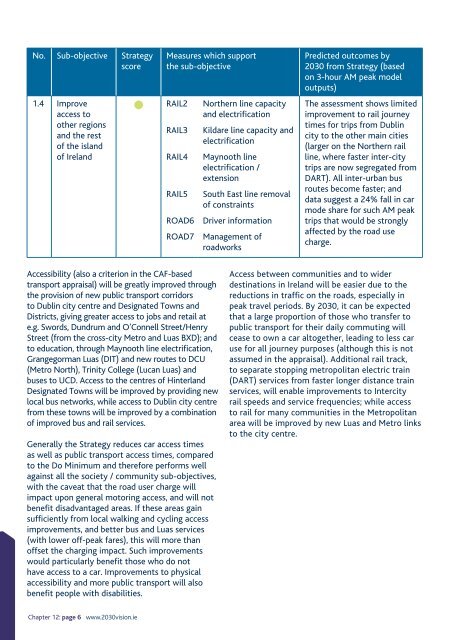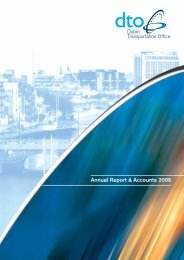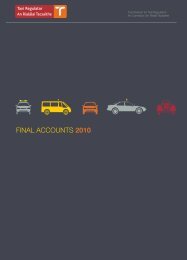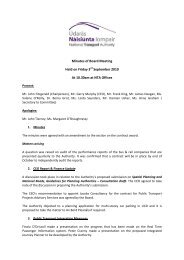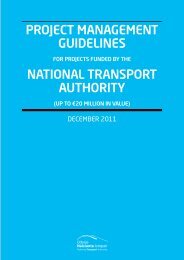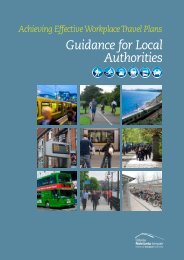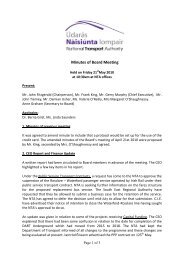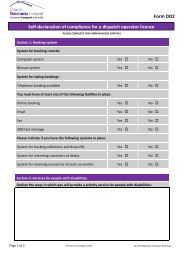Greater Dublin Area Draft Transport Strategy 2011-2030
Greater Dublin Area Draft Transport Strategy 2011-2030
Greater Dublin Area Draft Transport Strategy 2011-2030
- No tags were found...
Create successful ePaper yourself
Turn your PDF publications into a flip-book with our unique Google optimized e-Paper software.
No. Sub-objective <strong>Strategy</strong>score1.4 Improveaccess toother regionsand the restof the islandof IrelandMeasures which supportthe sub-objectiveRAIL2RAIL3RAIL4RAIL5ROAD6ROAD7Northern line capacityand electrificationKildare line capacity andelectrificationMaynooth lineelectrification /extensionSouth East line removalof constraintsDriver informationManagement ofroadworksPredicted outcomes by<strong>2030</strong> from <strong>Strategy</strong> (basedon 3-hour AM peak modeloutputs)The assessment shows limitedimprovement to rail journeytimes for trips from <strong>Dublin</strong>city to the other main cities(larger on the Northern railline, where faster inter-citytrips are now segregated fromDART). All inter-urban busroutes become faster; anddata suggest a 24% fall in carmode share for such AM peaktrips that would be stronglyaffected by the road usecharge.Accessibility (also a criterion in the CAF-basedtransport appraisal) will be greatly improved throughthe provision of new public transport corridorsto <strong>Dublin</strong> city centre and Designated Towns andDistricts, giving greater access to jobs and retail ate.g. Swords, Dundrum and O’Connell Street/HenryStreet (from the cross-city Metro and Luas BXD); andto education, through Maynooth line electrification,Grangegorman Luas (DIT) and new routes to DCU(Metro North), Trinity College (Lucan Luas) andbuses to UCD. Access to the centres of HinterlandDesignated Towns will be improved by providing newlocal bus networks, while access to <strong>Dublin</strong> city centrefrom these towns will be improved by a combinationof improved bus and rail services.Generally the <strong>Strategy</strong> reduces car access timesas well as public transport access times, comparedto the Do Minimum and therefore performs wellagainst all the society / community sub-objectives,with the caveat that the road user charge willimpact upon general motoring access, and will notbenefit disadvantaged areas. If these areas gainsufficiently from local walking and cycling accessimprovements, and better bus and Luas services(with lower off-peak fares), this will more thanoffset the charging impact. Such improvementswould particularly benefit those who do nothave access to a car. Improvements to physicalaccessibility and more public transport will alsobenefit people with disabilities.Access between communities and to widerdestinations in Ireland will be easier due to thereductions in traffic on the roads, especially inpeak travel periods. By <strong>2030</strong>, it can be expectedthat a large proportion of those who transfer topublic transport for their daily commuting willcease to own a car altogether, leading to less caruse for all journey purposes (although this is notassumed in the appraisal). Additional rail track,to separate stopping metropolitan electric train(DART) services from faster longer distance trainservices, will enable improvements to Intercityrail speeds and service frequencies; while accessto rail for many communities in the Metropolitanarea will be improved by new Luas and Metro linksto the city centre.Chapter 12: page 6 www.<strong>2030</strong>vision.ie


